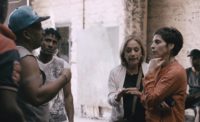Homage to Brassai
London, England
negative 1983/print 1984
Toned gelatin silver print
Gift of the George H. Ebbs Family, 2007.51.52
Architecture has been an irresistible subject for photographers since the birth of the medium, and like buildings themselves, architectural photography can be different things to different people—a malleability explored in the excellent exhibition Architecture + Photography, on view at the Carnegie Museum of Art in Pittsburgh through May 26.
Using materials from the museum’s Heinz Architectural Center and Department of Photography, curator Tracy Myers and assistant Alyssum Skjeie built the show around four intersections between photography and architecture over a period of more than a century. The sexiest component by far is the recently-acquired portfolio of a dozen black and white Ezra Stoller photographs. A prominent mid-century architectural photographer, Stoller shot many now-iconic buildings, like Frank Lloyd Wright’s Guggenheim, Eero Saarinen’s JFK TWA Terminal, and Louis Kahn’s Salk Institute, as pieces of functional art. His 1962 photo of the interior of the TWA Terminal is particularly appealing for its composition—the undulating curves of Saarinen’s building embracing a small cohort of travelers and families as they pass through the front door into the chiaroscuro created by a flood of sunlight—as an impression of the era’s verve and idealism. But equally catching are his almost abstract images of Kitt Peak National Observatory, also from 1962, and the Salk Institute, taken in 1977, which seem to capture in microcosm the spirit of the buildings.
Stoller’s photos are unassailable works of art. They’re also artifacts of commercialism, used to sell the buildings to the public (and the architects to new clients). But the Carnegie surrounds Stoller's work with images produced strictly for the public’s benefit. One is a series of 52 photos pulled from the Carnegie Art Reference Set, which was distributed to schools and libraries across America in the 1920s as a “comprehensive tool for the teaching of the humanities.” The images show landmarks like the Great Pyramids, the Sphinx, and classical ruins with a postcard-like quality. But some are truly magnificent, like Unknown Abbey from Northeast, Mont-St.-Michel, a gorgeously framed image full of mystery, spirituality, and symmetry.
The third section of the show is a cache of 25 photographs of Charleston, South Carolina, taken by Frances Benjamin Johnston in the 1930s. They are drawn from her larger, 7,100-negative survey, the Carnegie Survey of Architecture of the South, which she hoped would spur a preservation movement to save the region’s disappearing architectural heritage. The haunting images of derelict public buildings and crumbling homes recall the work of photographers like Walker Evans, Eugene Atget, and Charles Marville. And they did their job: The wall text shows smaller images of what 19 of the 25 structures look like today—saved in part by Johnston’s work.
The exhibition concludes with 24 photographs inspired by architecture; images taken not for commercial or civic aims but because something about a structure spoke to the person behind the camera. These photos are by far the most subjective and guided by curatorial tastes than any other part of the show. Some images would be more at home at an exhibit on "industry and photography," while others feel like literal interpretations of “architecture-plus-photography.” But there are a few that stand out, especially Mark Perrott’s haunting 2005 photo E BLOCK: Welcome Home, which captures the desolation and social isolation of a well-used prison. Meanwhile, Algimantas S. J. Kezys’ 1965 image of Las Vegas pops with the deliriousness of old Vegas and its gaudy neon (despite being in sharp black and white).
Despite this section's weakness relative to the rest of the show, these images are the ideal—indeed, only—way to close the circuit of Architecture + Photography. The exhibition is an indispensable survey of the symbiotic relationship that exists between the two art forms, and it’s the kind of expansive yet focused treatment this subject demands and deserves.









Post a comment to this article
Report Abusive Comment